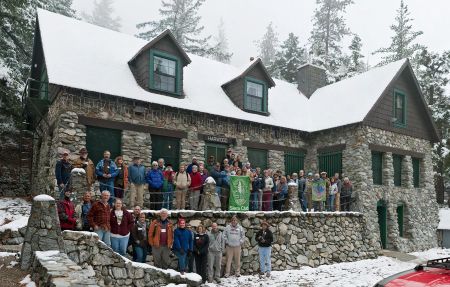by Bob Gates
Angeles Chapter Historian
 |
| Chapter members at Harwood Lodge, the building named for the Sierra Club's first woman president photo Peter Mason/Camera Committee |
More than 60 local Sierra Club members on Nov. 5 braved the icy road to Mt. Baldy Village to bask in the cheery warmth of Harwood Lodge and celebrate the first century (plus four days) of the Sierra Club in Southern California.
In number of participants, the celebration party approximated the size of the initial gathering on Nov. 1, 1911, at the Knickerbocker Building in downtown Los Angeles when the Southern California Chapter of the Sierra Club was born.
As the Club’s first chapter, we were a grand experiment — and can proudly boast that the optimism of our founders was well-placed: The spirit of innovation has continued within our organization from day one to the present. In the intervening decades, we have spun off sibling chapters throughout Southern California, changed our name to the Angeles Chapter and become the largest chapter of the Sierra Club.
Formed primarily to foster and expand upon the adventurous social life of the Club’s yearly High Trips, our forebears early on created an innovative outings program that became the heart and soul of the Angeles Chapter. Special-interest activity groups have flourished in this environment: mountaineering sections, nature study groups, river touring, bicycling, skiing, and of course, hiking, hiking, hiking.
The framework provided by the outings program provided an umbrella and operational model for many other diverse groups that made their first appearance in the Club within the Angeles Chapter: Sierra Singles, Gay and Lesbian Section, International Community, K-9 Hikers, Little Hikers, and Inner City Outings, among others.
Nor was conservation neglected throughout the years. How fitting it was to have our Centennial Celebration at Harwood Lodge, named in honor of Aurelia Harwood, who in 1919 led the chapter in the initial effort to set aside state lands in the San Jacinto Mountains as a wildlife preserve. (Not only was Harwood our first clearly defined chapter conservation activist, she became the first woman to be president of the Sierra Club, another first for our chapter.)
In the early decades, the Chapter followed the lead of the mother club in terms of conservation issues, but we provided strong input to those policies through the board members we elected, people such as Phil Bernays, Ernest Dawson, Nathan Clark, Harold Crowe, and the aforesaid Harwood.
But it was chapter member Weldon Fairbanks Heald who may rightly be called the true Father of Conservation in the chapter, as well as in the Sierra Club as a whole. Decommissioned from World War II as a full-fledged colonel, Heald soon organized the Sierra Club conservation troops and had them marching in order as the first chair of both the Chapter and National Conservation committees.
Since 1945, the growth of the environmental movement within the Club has been nothing short of phenomenal. Southern Sierrans, as Chapter members are known, have been at the forefront of this movement, as illustrated by the 30 conservation entities now operating within the chapter (as opposed to 23 outings entities).
A major challenge for our second century will be to maintain the sense of community that first brought Sierra Club members living in Southern California together 100 years ago to form our chapter.
We are after all a “club,” not an association or league or confederation. Judging by the warm feelings of camaraderie expressed by our membership at the various Centennial events throughout the year, that club spirit is still alive and well. Despite the tremendous growth and changes in the Sierra Club, had the original founders of the Southern California Chapter been magically transported to Harwood Lodge on Nov. 5 last year, they would have felt perfectly at home.